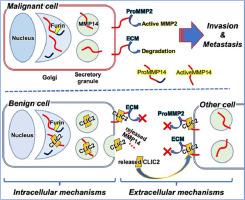Neoplasia ( IF 6.3 ) Pub Date : 2021-07-03 , DOI: 10.1016/j.neo.2021.06.001 Saya Ozaki 1 , Akihiro Umakoshi 2 , Hajime Yano 2 , Shota Ohsumi 2 , Yutaro Sumida 2 , Erika Hayase 2 , Eika Usa 2 , Afsana Islam 2 , Mohammed E Choudhury 2 , Yusuke Nishi 3 , Daisuke Yamashita 1 , Yoshihiro Ohtsuka 1 , Masahiro Nishikawa 1 , Akihiro Inoue 1 , Satoshi Suehiro 1 , Jun Kuwabara 4 , Hideaki Watanabe 1 , Yasutsugu Takada 3 , Yuji Watanabe 4 , Ichiro Nakano 5 , Takeharu Kunieda 1 , Junya Tanaka 2

|
The abilities to invade surrounding tissues and metastasize to distant organs are the most outstanding features that distinguish malignant from benign tumors. However, the mechanisms preventing the invasion and metastasis of benign tumor cells remain unclear. By using our own rat distant metastasis model, gene expression of cells in primary tumors was compared with that in metastasized tumors. Among many distinct gene expressions, we have focused on chloride intracellular channel protein 2 (CLIC2), an ion channel protein of as-yet unknown function, which was predominantly expressed in the primary tumors. We created CLIC2 overexpressing rat glioma cell line and utilized benign human meningioma cells with naturally high CLIC2 expression. CLIC2 was expressed at higher levels in benign human brain tumors than in their malignant counterparts. Moreover, its high expression was associated with prolonged survival in the rat metastasis and brain tumor models as well as with progression-free survival in patients with brain tumors. CLIC2 was also correlated with the decreased blood vessel permeability likely by increased contents of cell adhesion molecules. We found that CLIC2 was secreted extracellularly, and bound to matrix metalloproteinase (MMP) 14. Furthermore, CLIC2 prevented the localization of MMP14 in the plasma membrane, and inhibited its enzymatic activity. Indeed, overexpressing CLIC2 and recombinant CLIC2 protein effectively suppressed malignant cell invasion, whereas CLIC2 knockdown reversed these effects. Thus, CLIC2 suppress invasion and metastasis of benign tumors at least partly by inhibiting MMP14 activity.
中文翻译:

氯离子胞内通道蛋白 2 分泌并抑制 MMP14 活性,同时阻止肿瘤细胞侵袭和转移
侵入周围组织和转移到远处器官的能力是区分恶性和良性肿瘤的最突出的特征。然而,阻止良性肿瘤细胞侵袭和转移的机制仍不清楚。通过使用我们自己的大鼠远处转移模型,将原发性肿瘤细胞的基因表达与转移性肿瘤细胞的基因表达进行了比较。在许多不同的基因表达中,我们专注于氯细胞内通道蛋白 2 (CLIC2),这是一种功能未知的离子通道蛋白,主要在原发性肿瘤中表达。我们创建了过表达 CLIC2 的大鼠神经胶质瘤细胞系,并利用了具有天然高 CLIC2 表达的良性人脑膜瘤细胞。CLIC2 在良性人脑肿瘤中的表达水平高于在恶性脑肿瘤中的表达水平。而且,它的高表达与大鼠转移和脑肿瘤模型中的延长生存期以及脑肿瘤患者的无进展生存期有关。CLIC2 还与可能由细胞粘附分子含量增加而降低的血管通透性相关。我们发现 CLIC2 在细胞外分泌,并与基质金属蛋白酶 (MMP) 14 结合。此外,CLIC2 阻止了 MMP14 在质膜中的定位,并抑制了其酶活性。实际上,过表达 CLIC2 和重组 CLIC2 蛋白有效地抑制了恶性细胞侵袭,而 CLIC2 敲低则逆转了这些作用。因此,CLIC2 至少部分通过抑制 MMP14 活性来抑制良性肿瘤的侵袭和转移。











































 京公网安备 11010802027423号
京公网安备 11010802027423号